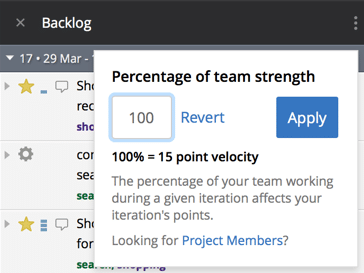Article summary
I was reluctant to embrace Pivotal Tracker when I joined Atomic because I valued Jira so highly. But over the last year, I’ve come to rely on a handy feature that I didn’t have with Jira — Team Strength. Why? It allows me to adjust overall velocity by configuring variations in my team’s schedule from iteration to iteration.
Adjusting Team Velocity
Predictability allows the client to successfully plan releases. As a Delivery Lead, I am continually asked, “What can you deliver by (fill in the blank) date?” Team velocity is the biggest indicator of where we’ll end up at the end of any given iteration.
In order to dial in my team’s velocity, I have to take into account their holidays, vacations, and time away from working on the project. As I write this, I’m working on a project with a rigid timeline constraint. My client’s go-live date is right after the new year begins. I must make certain that we hit this milestone regardless of where the winter holidays fall in this schedule.

With Team Strength (available in the iteration header to the right of the dates), I can predict with a high degree of certainty how much work we can complete, even factoring in holiday vacation schedules.
How it Works
Pivotal fills the current iteration with as many story points as the current velocity value. The velocity value is based on the prior three iterations worth of work, but you can choose anywhere from one to four iterations. If there are no prior iterations, the default is 10 story points.
Imagine a team of four developers working in 10-day iterations. Two of the developers are planning to take four vacation days during the iteration, which also includes the Thanksgiving holiday.
The calculation works like this:
- 4 developers x 10 days = 40 maximum workdays in the iteration
- 40 – 8 (total number of vacation days) = 32
- 32 / 40 = .80
So the projected velocity for that particular iteration is 80%. This is the number I enter into Pivotal’s “Percentage of Team Strength” box. It tells Pivotal that my team will be operating at 80% of our velocity potential for that particular iteration.
After I enter the calculated percentage, Pivotal adjusts the velocity accordingly. I can now see how many story points my team is projected to complete.
There are a couple of other things to note.
- Using this feature does not override the project’s actual velocity. It only projects velocity under possible conditions.
- This feature can also be used to adjust team strength for future sprints and those which have passed.
The next time you have to plan around vacations, sick days, maternity leave, conferences, etc., try using this feature in Pivotal to increase predictability.

